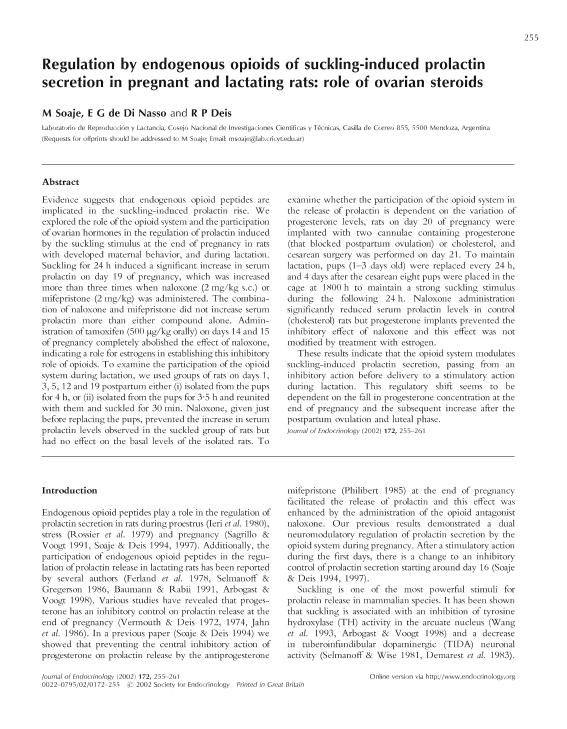Artículo
Regulation by endogenous opioids of suckling-induced prolactin secretion in pregnant and lactating rats: Role of ovarian steroids
Fecha de publicación:
02/2002
Editorial:
BioScientifica
Revista:
Journal of Endocrinology
ISSN:
0022-0795
Idioma:
Inglés
Tipo de recurso:
Artículo publicado
Clasificación temática:
Resumen
Evidence suggests that endogenous opioid peptides are implicated in the suckling-induced prolactin rise. We explored the role of the opioid system and the participation of ovarian hormones in the regulation of prolactin induced by the suckling stimulus at the end of pregnancy in rats with developed maternal behavior, and during lactation. Suckling for 24 h induced a significant increase in serum prolactin on day 19 of pregnancy, which was increased more than three times when naloxone (2 mg/kg s.c.) or mifepristone (2 mg/kg) was administered. The combination of naloxone and mifepristone did not increase serum prolactin more than either compound alone. Administration of tamoxifen (500 μg/kg orally) on days 14 and 15 of pregnancy completely abolished the effect of naloxone, indicating a role for estrogens in establishing this inhibitory role of opioids. To examine the participation of the opioid system during lactation, we used groups of rats on days 1, 3, 5, 12 and 19 postpartum either (i) isolated from the pups for 4 h, or (ii) isolated from the pups for 3.5 h and reunited with them and suckled for 30 min. Naloxone, given just before replacing the pups, prevented the increase in serum prolactin levels observed in the suckled group of rats but had no effect on the basal levels of the isolated rats. To examine whether the participation of the opioid system in the release of prolactin is dependent on the variation of progesterone levels, rats on day 20 of pregnancy were implanted with two cannulae containing progesterone (that blocked postpartum ovulation) or cholesterol, and cesarean surgery was performed on day 21. To maintain lactation, pups (1-3 days old) were replaced every 24 h, and 4 days after the cesarean eight pups were placed in the cage at 1800 h to maintain a strong suckling stimulus during the following 24 h. Naloxone administration significantly reduced serum prolactin levels in control (cholesterol) rats but progesterone implants prevented the inhibitory effect of naloxone and this effect was not modified by treatment with estrogen. These results indicate that the opioid system modulates suckling-induced prolactin secretion, passing from an inhibitory action before delivery to a stimulatory action during lactation. This regulatory shift seems to be dependent on the fall in progesterone concentration at the end of pregnancy and the subsequent increase after the postpartum ovulation and luteal phase.
Palabras clave:
Endogenous opioids
,
Suckling
,
Rat
,
Ovarian steroids
Archivos asociados
Licencia
Identificadores
Colecciones
Articulos(IMBECU)
Articulos de INST. DE MEDICINA Y BIO. EXP. DE CUYO
Articulos de INST. DE MEDICINA Y BIO. EXP. DE CUYO
Citación
Soaje, Marta; de Di Nasso, E. G.; Deis, Ricardo; Regulation by endogenous opioids of suckling-induced prolactin secretion in pregnant and lactating rats: Role of ovarian steroids; BioScientifica; Journal of Endocrinology; 172; 2; 2-2002; 255-261
Compartir
Altmétricas




